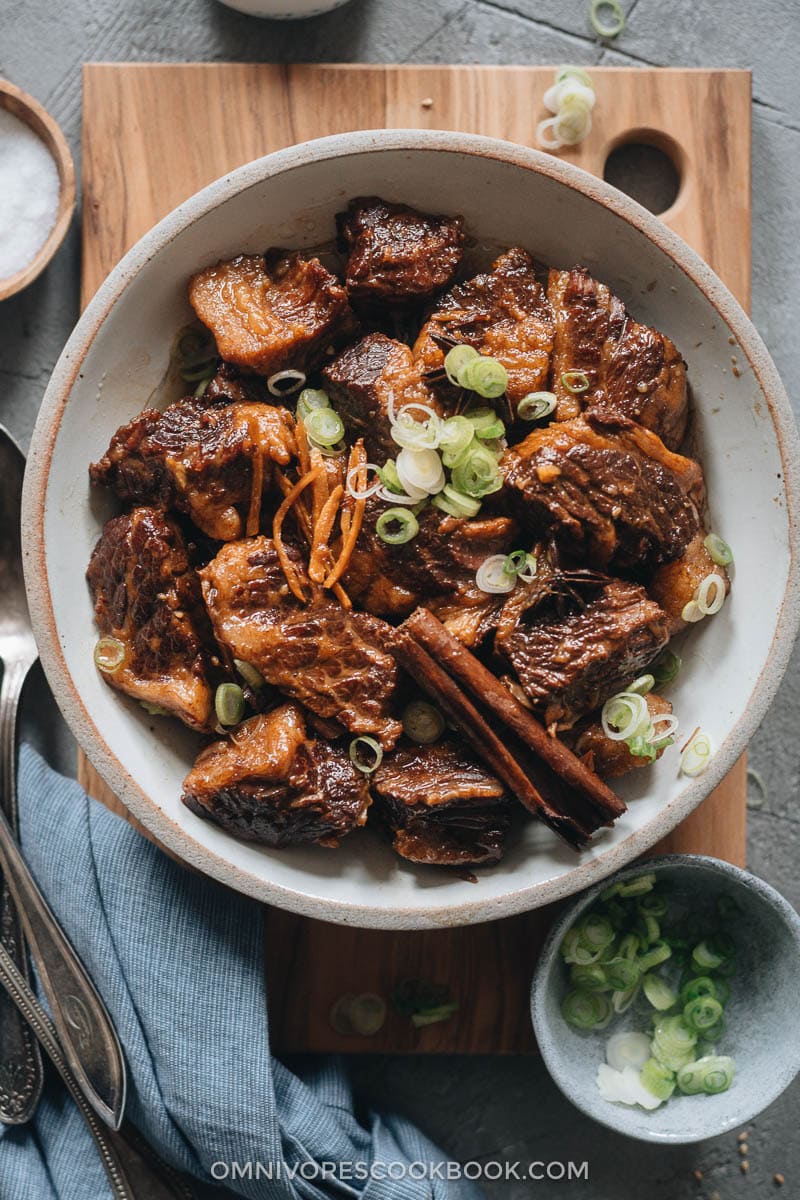
The Instant Pot is a perfect appliance for cooking ingredients that require a long cooking time, such as beans and meat. For dishes such as braised beef, it reduces hours of cooking into one hour (or less, depending on the cut you use) and creates a great result. Today I want to introduce this Chinese braised beef that you can make in the Instant Pot.
Why this recipe
- It’s easy to prepare and only requires 15 minutes of active cooking time.
- There’s no browning required! It will make the cooking much easier and less messy.
- I’ll introduce a secret sauce to make your braised beef immediately even tastier.
- The finished dish is very well balanced and rich with buttery tender meat.
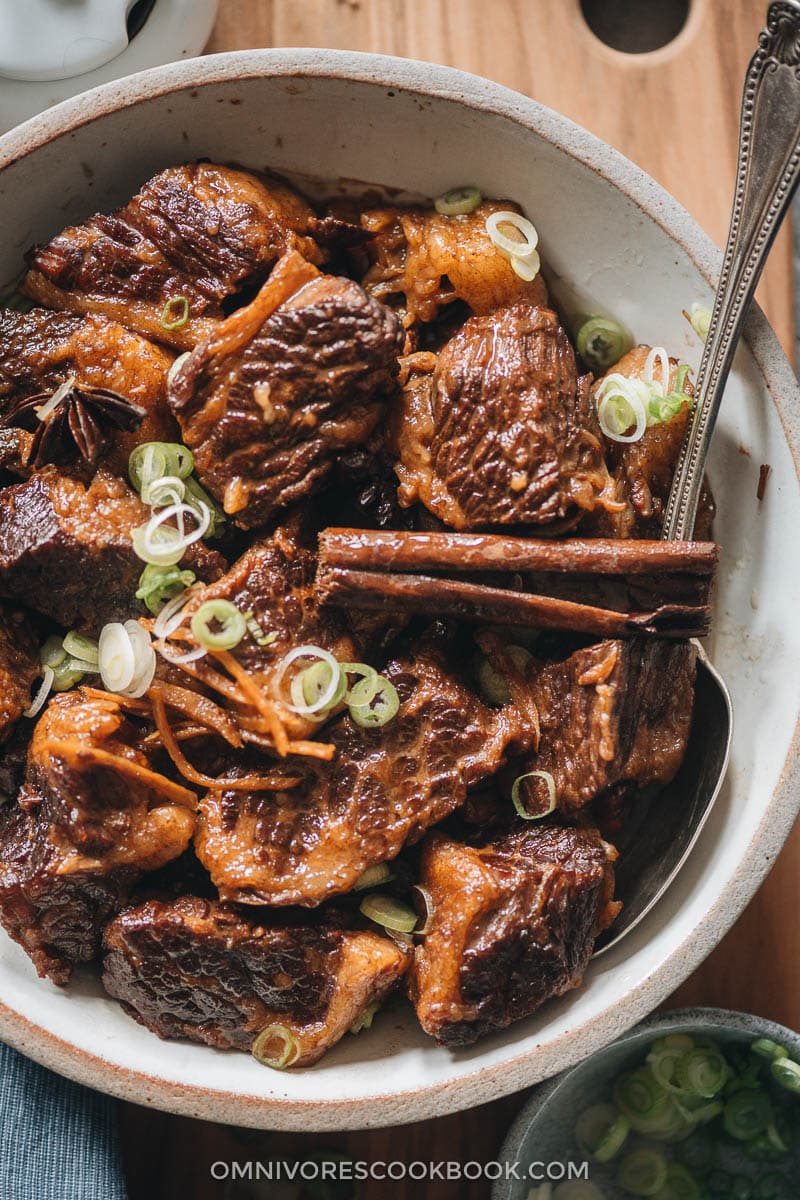
Which cut of beef to use
The rule of thumb when braising beef is to use a well-marbled and fatty cut. The more fat it contains, the more tender the meat will become.
- My personal favorite cut is shin bones. Shin bones contain a lot of collagen between the lean meat. It will become super tender after cooking and taste heavenly.
- Fatty brisket is great, too, and it’s usually less expensive. The layer of fat will protect the lean meat, so the meat will be super tender after braising.
- Beef neck bones are another good option. The meat and broth will be extra flavorful, but will yield less meat since it’s mostly bone.
- Chuck is another good option and requires less cooking time, even though it’s on the leaner side compared to the other cuts.
NOTE: Avoid stew meat when possible. It’s usually very lean and cut unevenly, so it isn’t suitable for braising.
In this recipe I used a VERY fatty cut of brisket, due to the availability at my local market.
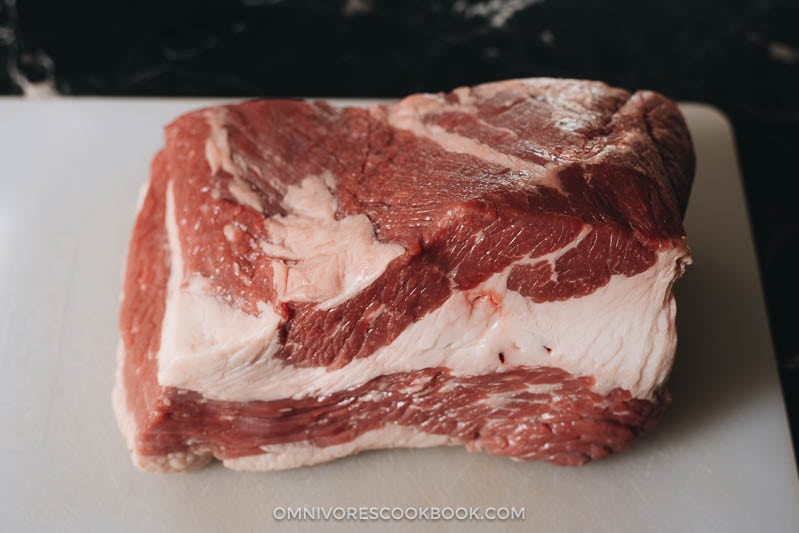
How to cut beef for braising
DO NOT trim off the fat. That’s the one thing that matters most. The fat will protect the lean meat from drying out during cooking, producing an extra tender result.
You will see that the cut of brisket I used is super fatty.
- I split the meat down the middle of the fat layer, so the lean meat would have some fat attached.
- Then I cut the meat into 2” (5 cm) chunks, as evenly as I could.
A lot of the fat will melt away during the cooking. But don’t worry. You can easily skim the oil off the liquid once you’re done cooking. If you do not like the fat attached to the lean meat, simply trim it off of the cooked beef.
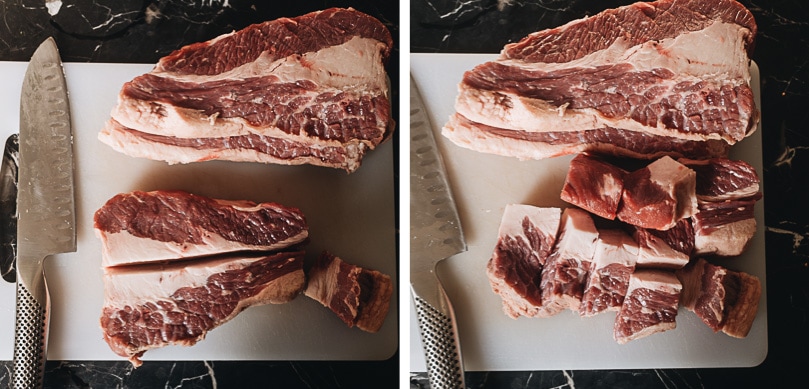
Secret sauce
Chee Hou Sauce (柱候酱, Zhu Hou Jiang), or Chou Hou Sauce, is a thick dark brown sauce that is made with soybeans, ginger, garlic, sugar, and sesame seeds. It is somewhere between the taste of oyster sauce and hoisin sauce, with a savory essence that is lightly sweet. It’s a sauce that’s commonly used in Cantonese cuisine, especially for braising beef brisket.
We tested the Instant Pot braised beef with and without the sauce. We found that the version with the sauce has a much better aroma and is more well-rounded in flavor.
You can easily find Chee Hou Sauce in Asian markets sauce aisle or on Amazon.
NOTE: If you do not have that sauce, oyster sauce is the best replacement.
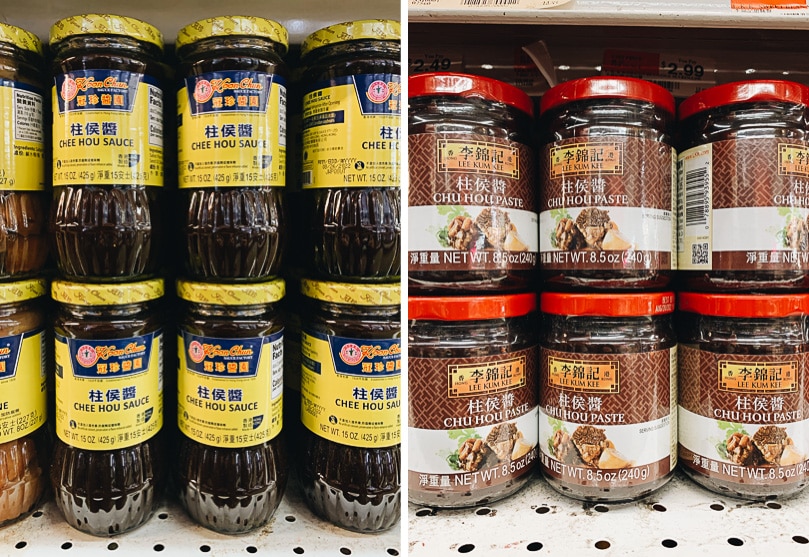
TIP: Have leftover Chee Hou sauce once you cooked this recipe? Check out my super easy Choy Sum with Garlic Sauce, that uses Chee Hou sauce to create a scrumptious side dish in no time!
Cooking process
Cooking Instant Pot braised beef is so easy. There are only two steps:
(1) Blanch the beef
- Boil the beef with aromatics.
- Skim off the foam.
- Let it cook for 10 minutes.
- Rinse the beef to remove any excess foam.
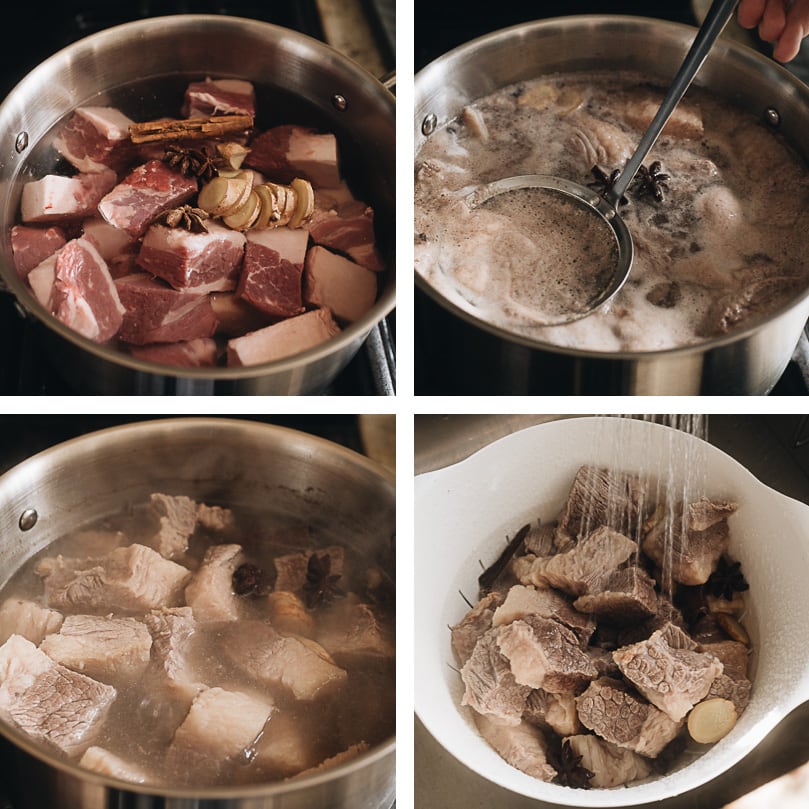
This process will remove the impurities from the beef and create a clear broth at the same time. You will use some of the blanching liquid in the cooking, and you can reserve the rest to use as beef stock.
NOTE: I did this step in a separate pot. But you can do it in the Instant Pot as well.
(2) Set up the Instant Pot
- Saute the aromatics to release their fragrance.
- Add everything, set the timer, and wait.
- The beef will be done in 1 hour (or less, depending on the cut you use)
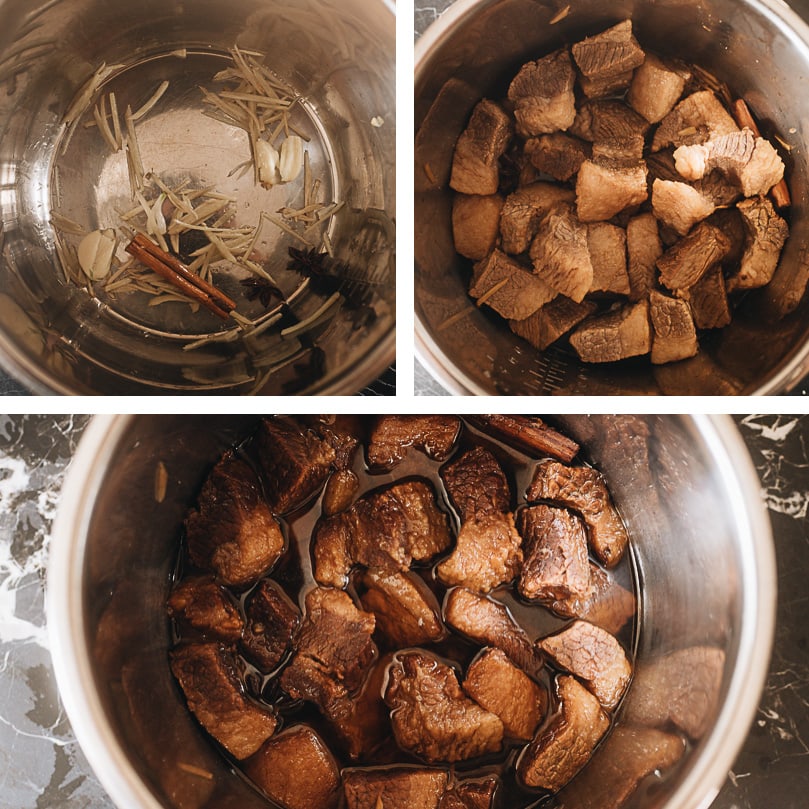
How to serve
I highly recommend making the braised beef ahead of time and letting it sit in the fridge overnight before eating it. The sauce will have a rounder taste and the meat will be more flavorful.
I enjoy serving the beef with the sauce on steamed rice with a side of steamed veggies. The veggies will taste great dipped in the braising sauce.
You can also use some of the braising liquid to cook veggies, such as napa cabbage, daikon radish, cauliflower, baby bok choy, and broccoli.
Making a balanced meal couldn’t be easier!
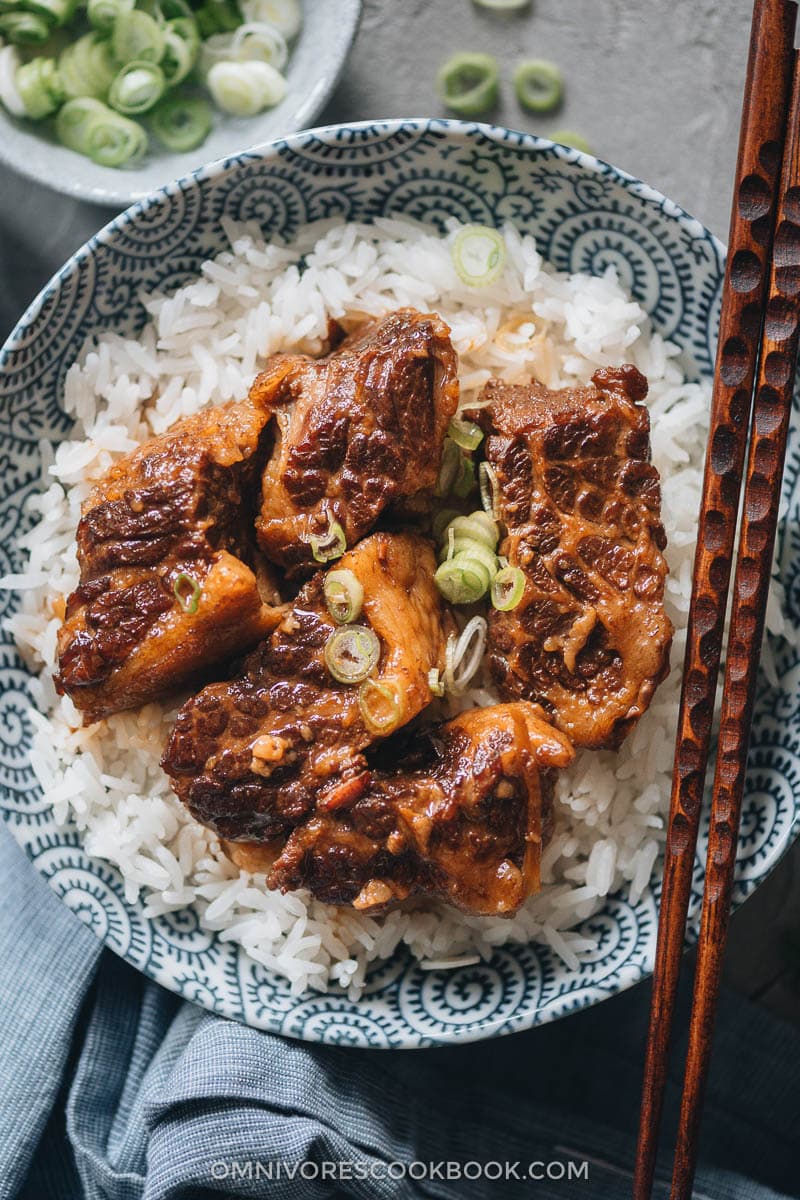
More delicious Instant Pot recipes
- Instant Pot Chinese Sausage Rice
- Instant Pot Pork Ribs (Chinese-Style)
- Instant Pot Oxtail Soup
- Asian-Style Instant Pot Pulled Pork
If you give this recipe a try, let us know! Leave a comment, rate it (once you’ve tried it), and take a picture and tag it @omnivorescookbook on Instagram! I’d love to see what you come up with.
Chinese Cooking Made Easy
Are you new to this website? This free email series is a great place to start. I’ll walk you through a few of my most popular recipes and show you how and why they work. You’ll quickly start to cook better Chinese food in your own kitchen.

Instant Pot Braised Beef (Chinese-Style)
Ingredients
- 2.5 to 3 lbs brisket , cut into 2” (5 cm) chunks (neck bone, shin bone, or chuck)
Blanching
- 2 ” ginger , sliced
- 1 cinnamon stick
- 2 star anise pods
Braising
- 1 tablespoon peanut oil
- 2 ” ginger , cut to think strips
- 2 cloves garlic , smashed
- 2 star anise pods
- 1 cinnamon stick
- 1/4 cup Shaoxing wine (or dry sherry)
- 2 tablespoons soy sauce
- 1 tablespoon dark soy soy
- 1 tablespoon Chee Hou sauce (or oyster sauce)
- 1 tablespoon sugar
- 3/4 cup reserved blanching broth
Instructions
- Add the beef and 6 cups of water into a medium-sized pot. Add all the ingredients listed under “Blanching” above. Heat over medium-high heat until boiling. Turn to medium heat. Skim away any brown foam that rises to the top, until the broth runs clear, 10 minutes or so. (*Footnote 1)
- Transfer the blanched beef to a colander and reserve the braising liquid (*Footnote 2). Run tap water over the beef and shake the beef, to rinse off any residue.
- Turn on the Instant Pot’s “Saute” function. Let it heat up until it shows “HOT”.
- Add the oil, ginger, garlic, star anise, and cinnamon stick. Saute until the ginger and garlic begin to brown, 2 minutes or so.
- Add the Shaoxing wine. Scrape off any brown bits from the bottom of the pot using a wooden spatula.
- Add the rest of the “Braising” ingredients (soy sauce, dark soy sauce, Chee Hou Sauce, sugar, and the reserved blanching broth) and stir to mix well.
- Add the blanched beef and stir. Arrange the beef into an even layer.
- Seal the Instant Pot and make sure the valve lock is on. Set to “Manual” at “High Pressure”. Set the timer for 60 minutes if using brisket, 50 minutes for neck bones and shin bones, and 40 minutes for chuck.
- Once the Instant Pot is done cooking, let it release the pressure naturally.
- Open the Instant Pot and stir the beef with the broth. (*Footnote 3)
- The beef is ready to serve now. For a better result, let the beef sit in the braising liquid the fridge overnight, so the seasonings will round out more and the beef will be more flavorful.
- Serve the beef hot over steamed rice as a main course.
Notes
- You can do this step directly in the Instant Pot, as well. However, I prefer to blanch the beef on the stove top because it’s easier to control the heat.
- You only need 3/4 of a cup blanching liquid in this recipe. You can also reserve the rest of the liquid to use as beef stock in the future. I recommend using the liquid to make braised daikon radish with minced pork (use it in place of the chicken broth).
- If you’re using a fatty cut of beef, you might want to skim the floating oil from the top of the broth. You can do this with a ladle once you’re done cooking. For a better result, you can chill the beef in the fridge so the fat will congeal into a solid layer on top. Then you can easily remove the fat.
Nutrition

Did you make this recipe?
I’d love to hear how it turned out for you! Please take a moment to leave a 5-star rating ⭐️ and share your thoughts in the comments further down the page. It really helps others discover the recipe too.
Lilja Walter is a part of the Omnivore’s Cookbook team who work with Maggie closely to develop and test this recipe.

Andrew Smith
Mine has a broth like texture and appearance after cooking in the instant pot. Are we supposed to reduce the sauce to make it thicker and darker?
Maggie Zhu
Hi Andrew, the liquid will be quite thin after cooking in the instant pot. You can indeed reduce the sauce for a thicker texture – I would take out the beef and keep cooking the sauce until it’s just turned a little thicker, and it will thicken up a little more once cooled off a bit.
Jean
I love this recipe. It’s so simply laid out and easy to follow.
I keep coming back every few months and making this (since 2021).
Thank you for a wonderful recipe
Jaime
The flavours were spot on! however, a good cut, and popular for this dish I think is the finger cut. Western brisket cut I find doesnt really work well. But usually for this dish is the other cut. Have you tried?
Maggie Zhu
I’m not familiar with the “finger cut” you mentioned. But if you purchase it in Chinatown, it is an untrimmed fatty brisket cut and it works better.
For Western brisket, try using point (second cut) which is fattier, and it also works fine.
The key is to use a fattier and well marbled cut if possible.
Sarah
This is SOOO good and easy even though I don’t have a crockpot or slow cooker but just braise in the oven at 100-120C for about 3 – 3,5 hours. The family’s former vegetarian loved it tonight, and I can’t wait to eat leftovers tomorrow
Cathy
Hi,
Just wondering after blenching, do you discard the ginger/cinnamon stick/star anise? Or add them all to the next step along with the beef?
Maggie Zhu
I transferred all the spices into the Instant Pot to cook with the beef.
Dug the slug
Nice and easy recipe. Thank you so much for all your hard work sharing these recipes, Ms. Zhu. I’m off work this year, and am planning on trying many of your amazing recipes. The layout, photos, and explanations make everything easy, (love the serving calculator!) I also love the explanations of different ingredients you go through. I have access to a good asian grocery, but it can still be daunting to get the right product. Of course, the taste is what we come for. I was looking for authentic asian recipes, and yours fits the bill! The family loved this. The meat came out tender and full of taste. Hoping to master some chow mein next!
Nienke
Hi Maggie, looks like a recipe my family Will enjoy! Would this also work with beef cheeks? And then pressure Cook for about 25 minutes? Thanks!
Maggie Zhu
You can definitely cook this recipe with beef cheeks. The cut is tougher so you will need a longer cooking time, around 35 to 40 minutes so the meat will be tender.
Nienke
Super, thanks! Will try this week!
Elizabeth Whatley
When do you add the choice hee, soy, and sugar? It doesn’t say
Maggie Zhu
Sorry my writing was not very clear. They should be added at step 6, after you add the blanched beef. I just updated my recipe so the language is more accurate.
Twinkle
Hello! This recipe looks fantastic and I plan on getting the ingredients this weekend. I realize the recipe wasn’t developed with additional vegetables but if I wanted to add daikon, should I add additional liquid? Thanks!
Maggie Zhu
Not sure if you plan to add the radish at the beginning or after the beef is cooked. If adding with the beef, I would leave the radish in very big pieces so they won’t dissolve. You also don’t need extra liquid in this case.
I personally prefer to cook vegetables after the beef is done to prevent overcooking. If that’s the case, the best way is to remove all the beef from the pot and use the existing liquid to cook the radish. You might need to add extra water (more liquid will evaporate when you cook the radish).
Valerie
Hi Maggie! I’ve made this recipe 3 times and loved, loved, loved it! I don’t use Shaoxing wine but use mirin instead. I’m making it today for a friend’s birthday party and tossing it in noodles. I am hoping everyone enjoys it as much as my husband and I do. Thank you. It’s so good!
Elaine kwan
Hi Maggie
I loved your recipes thank you so much for sharing with us! I especially love your no deep fry crispy chicken recipe!
I have a question about the instant pot braised beef, what should I do differently if I want to use my slow cooker to make it as I do not have an instant pot.
Thank you again
Elaine
Maggie
Hi Elaine, I think you can use the recipe directly for slow cooker. At step 8, you can simply put it on slow cooking for 8 hours.
Sue H.
Should I add more blanching liquid if cooking via the slow cooker method? I’m trying this dish for the first time and have the beef marinating in the braising liquid in the fridge right now.
Eric
Compared to the Chinese Beef Stew recipe, what are the differences?
In addition, can I add potatoes and carrots to the instant pot after about 1/2 an hour?
Maggie
This recipe uses chee hou sauce to add another layer of flavor, so it’s quite nice and tastes slightly different from the beef stew.
You can add potatoes and carrots but I highly recommend adding them at the last 10 minutes (if you use pressure cooking again) so they won’t over cook.
Nora-Adrienne Deret
Can you make the Chee Hou sauce at home? Lee Kum Chee is not kosher.
Maggie
I think you can but I don’t have a recipe at the moment. Can you find a kosher hoisin sauce? It’s a bit different but can be used here as a replacement.
Se
I don’t know why mine turned out tough and chewy? Thank you
Maggie
I think maybe it’s caused by the cut you use or how you cut the meat. Sometimes the meat just needs a bit extra cooking time to turn tender.
There’s another chance that your Instant Pot did not add pressure. So it basically boiled the beef instead of pressure cooking it. It happened to me a few times and the result was very upsetting. If your beef was extremely chewy and nowhere near tender, it might be due to the Instant Pot malfunction. In that scenario, you will just need set up the cooking again (maybe reduce a bit cooking time since the beef has cooked for a bit).
Ching Ng
Hi,
Can I use regular pot to make this and slow cooker?
thank you
Maggie
Yes you can. You will need to use more liquid because the cooking time will be longer. You can save the blanched water from boiling the beef and add 3 to 4 cups to the braising seasonings. Simmer over low heat until the beef turns tender. During the process you might need to add a bit more broth if the liquid runs too low. And at the end of cooking if there’s too much liquid, you can turn to medium heat, cook and stir until the sauce thickens.
Kristin
Hello! This recipe looks great! If I cook it and then eat the next day, what’s the best way to reheat the meat?
Maggie
Hi Kristin, the best way to reheat the meat is to steam them (prepare a steamer and reheat the beef in a bowl with sauce). But I usually just microwave it using a bowl with a plate to cover it. I think either way they will taste good if you cook ahead 🙂
Puagirl
Thank you! Enjoy reading and learning a lot!
Katharine
Thanks for this recipe, Maggie. The Chu Hou sauce is a great ingredient, especially for this comforting braise. Family and friends loved this dish. Made it 2 days beforehand – so easy (and economical) and such a rich result.
Monica
Such great flavors and so easy!! I used boneless short ribs and only left it on the heat for half an hour. I think next time I’ll try leaving the meat in the sauce overnight so that the flavors set deeper in the meat.
Nina Contini Melis
For those of us without a slow cooker, air fryer, instant pot or other newfangled gadgets, can you also give directions for a stove top pressure cooker or either oven or stove top cooking in a heavy pan?
Monica
I used a stove top pressure cooker for the recipe. In general to follow electric pressure cooker recipes, I add a little more liquid since more steam comes out on the stove top.